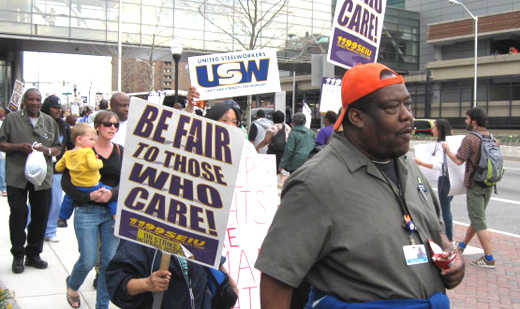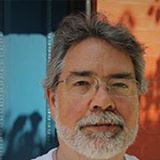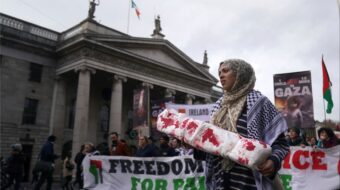
BALTIMORE-Healthcare workers of 1199-SEIU United Health Workers East struck the Johns Hopkins Hospital from 6 a.m., Wednesday, April 9 to 6 p.m., Friday, April 11. With over 2,000 workers in the unit, the picket line in front of the hospital’s main entrance had from 700 to 1,200 picketers during day shift picket duty. The three-day strike was the result of intransigence on the hospital’s part when they failed to present a counter offer to the union’s last proposal, the objective of which is to get the low -paid workers above the federal poverty level.
The union and those having a direct connection with patient care assured the public that the job action would not affect patient care. However, someone “on the inside” sent a cell phone photo of overflowing trash receptacles lined up because non-union employees couldn’t or wouldn’t take care of those problems in addition to replacing strikers.
Labor and community supporters were mobilized by the Maryland/DC AFL-CIO, SEIU, AFT, and Working Families. Direct picket line support came from USW, AFT, UFCW, UNITE/HERE, the Alliance for Retired Americans (ARA) and affiliated retiree groups and the Baltimore progressive community.
At a Wednesday evening rally held at St. Wenceslas Church, four blocks from the hospital, strikers told their stories as low-wage workers at the hospital. A two-year employee in Environmental Services told how he makes $11.19/hr. and can’t sustain his family, even with food stamps and medical assistance.
Another worker talked about her history at the Johns Hopkins Hospital. She was there for the recognition strike in 1969, when Coretta Scott King came and walked the picket line with strikers, and is back now, her second time around at JHH, for this strike. Her wage scale is less than $13.00 per hour. “Johns Hopkins and (Hospital President) Ron Peterson should be ashamed of themselves!” she said.
Two dozen doctors, faculty and medical and nursing students marched to the front of the rally declaring their support for the strikers. A spokesman of the group said they see the poorly paid Hopkins workers as emblematic, not only of low wage healthcare workers employed by the top ranked hospital in the U.S. , but as victims of economic inequality in 21st Century America. The physician declared “Hopkins has an international reputation on medical issues, medical research and medical education, and I’m surprised they can’t get this right!” A professor at the School of Public Health reported, “In class today we talked about a Living Wage as a public health issue, and some of my students are with me tonight. We’re with you, stay the course, living wage!” Some of the doctors and students joined the picket line on Friday in their lab coats, adding emphasis to their active support.
Fred Mason, President of the Maryland/DC AFL-CIO, speaking for 300,000 Maryland and DC union members, greeted the strikers and supporters as ‘family’ and called on labor everywhere to come out in support of the 1199SEIU strikers in the growing fight-back against declining union density in Maryland and around the country.
As John Reid, Exec. Director of 1199SEIU UHW-E, addressed the rally, he chanted, “Standing tall, looking good, you oughta be in Hollywood!” Reid explained that because of Hopkins’ size and influence, the hospital has managed to keep the wages in the rest of Baltimore flat!” “The workers, unseen in the lower levels and tunnels who do the tasks that those at the top turn their noses up at, are the Salt of the Earth,” he said.
Supporters included ironworkers, Healthcare for the Homeless, “Get the Money out of Maryland” (anti-Citizens United), the ARA, and elected union officials and labor candidates for the 2014 statewide elections. Ron DeJuliis, Commissioner of Labor and Industry for Maryland and former president of IUOE, participated.
The rally was kept to an hour so supporters could join the strikers on the line
The Hospital covers six city blocks and is surrounded by the Medical, Public Health and Nursing schools, university research and bio-medical buildings, ancillary support buildings and working class communities of African Americans, students, immigrants and whites.
The most visible picketing for the three days was done on Orleans St., U.S. Highway 40, in front of the park-like main entrance to the new $1.1 billion Children and Adult acute care centers. Most of the maintenance workers on day shift picketed the truck entrances to Central Receiving, a block south of the highly visible picket line on Orleans St. Teamsters Union drivers honored the picket lines, so trucks were turned away. In at least one instance, a rig that wouldn’t cross the line decided to turn around and wound up blocking traffic in both directions for about 20 chaotic minutes, much to the delight of the picketing maintenance workers.
In an April 11 op-ed Commentary in the Baltimore Sun, Peterson, whose annual pay is nearly $2 million per year, talked about how valued and important the Hopkins employees are and that Hopkins needs to “balance several different financial priorities within a finite pool of funds.” His low-wage employees understand quite well the need to find just such a balance between what they are paid for working, plus the amount by which their meager income is augmented by public assistance. 70 percent of the union workers earn less than $15.00 per hour, the rate at which a single parent with one child would qualify for food stamps.
The union’s wage proposal would add 0.32 percent to Hopkins’ $754 million payroll costs. The 2,000 union employees are 10 percent of the Hopkins 20,000 employee payroll. In 2013, Hopkins reported a surplus of $145 million.
Photo: Margaret Baldridge/PW

MOST POPULAR TODAY

High Court essentially bans demonstrations, freedom of assembly in Deep South

UN warns that Israel is still blocking humanitarian aid to Gaza

Resource wars rage in eastern Congo, but U.S. capitalism only sees investment opportunity

U.S. imperialism’s ‘ironclad’ support for Israel increases fascist danger at home







Comments